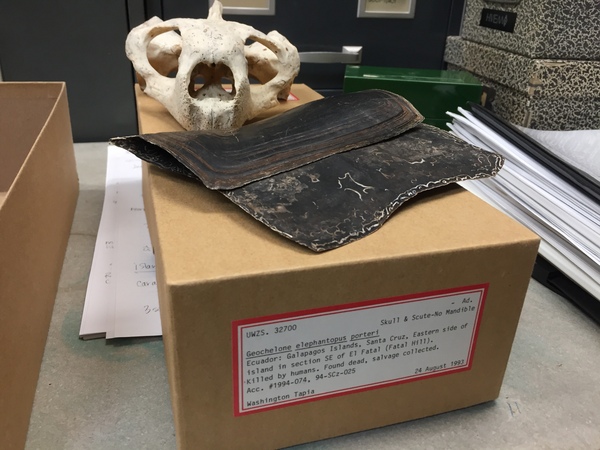
Photo: Kelly Tyrrell
MADISON – A new species of giant Galapagos tortoise, revealed this week in a study conducted by scientists at Yale University, also happened to be lurking in the collections of the University of Wisconsin-Madison’s Zoological Museum, it turns out.
The specimen – a skull and a couple of scutes, the keratin plates which overlie the bones making up the animal’s shell – was acquired by the museum in 1991 as part of a longstanding program with the Ecuadorean National Park Service to curate salvaged animal remains found on the Pacific islands made famous by Charles Darwin.
The UW-Madison specimen was loaned to the Yale group in 2009 and a small sample of skull bone, about the size of a paper clip, was contributed to the study, which mostly depended on genetic analysis of the living tortoises on Santa Cruz Island, one of 21 islands in the Galapagos archipelago.
The new species, dubbed Chelonoidis donfaustoi, exists in a population of about 250 animals that live in the arid eastern interior of Santa Cruz Island and are so genetically different from the rest of the island’s giant tortoises that researchers determined they deserved their own species designation.
The specimen in the UW-Madison Zoological Museum, which was returned this past week by the Yale Peabody Museum of Natural History, is considered the “holotype” specimen, meaning it is the defining scientific example of the new animal species. The UW-Madison museum has only eight holotypes – including a subspecies of cougar from Wisconsin and some frogs from Papua New Guinea – in its collection of 500,000 animal specimens.
“Having a holotype is a big deal in the museum world,” explains Laura Monahan, the museum’s senior curator. “It is the single specimen representing a species to which subsequent finds need to be compared.”
Under the direction of former curator Elizabeth Pillaert, the museum has enjoyed a long partnership with the Ecuadorean National Park Service, which oversees the volcanic islands, famous for their large number of endemic species, including 12 extant species of giant tortoise.
The UW-Madison Zoological Museum currently houses one of the largest collections of materials from the Galapagos in North America. When dead animals are found, many are sent to UW-Madison, where they are prepared and curated, with most being returned to Ecuador and the remainder staying in Madison. Scientists from Wisconsin and around the world use the specimens in various scientific studies.
“I wish we had more of the tortoise, but this is what we have,” says Monahan as she peers into the box with the skull and scutes. Given that Galapagos tortoises can live to be 150 years old, the UW-Madison Zoological Museum’s claim to a holotype for an iconic animal of evolutionary biology may last for a while with few additional specimens to represent the rare animal.








